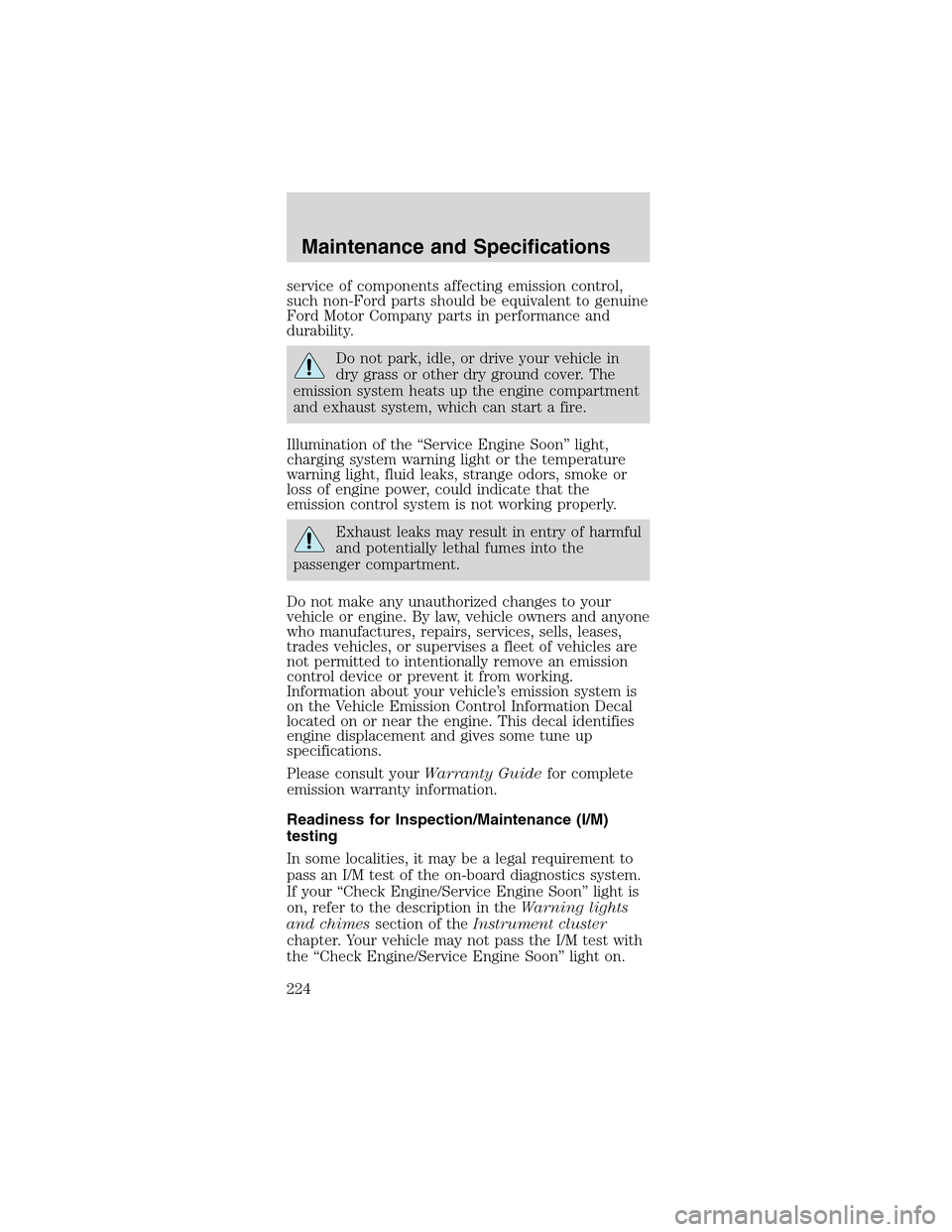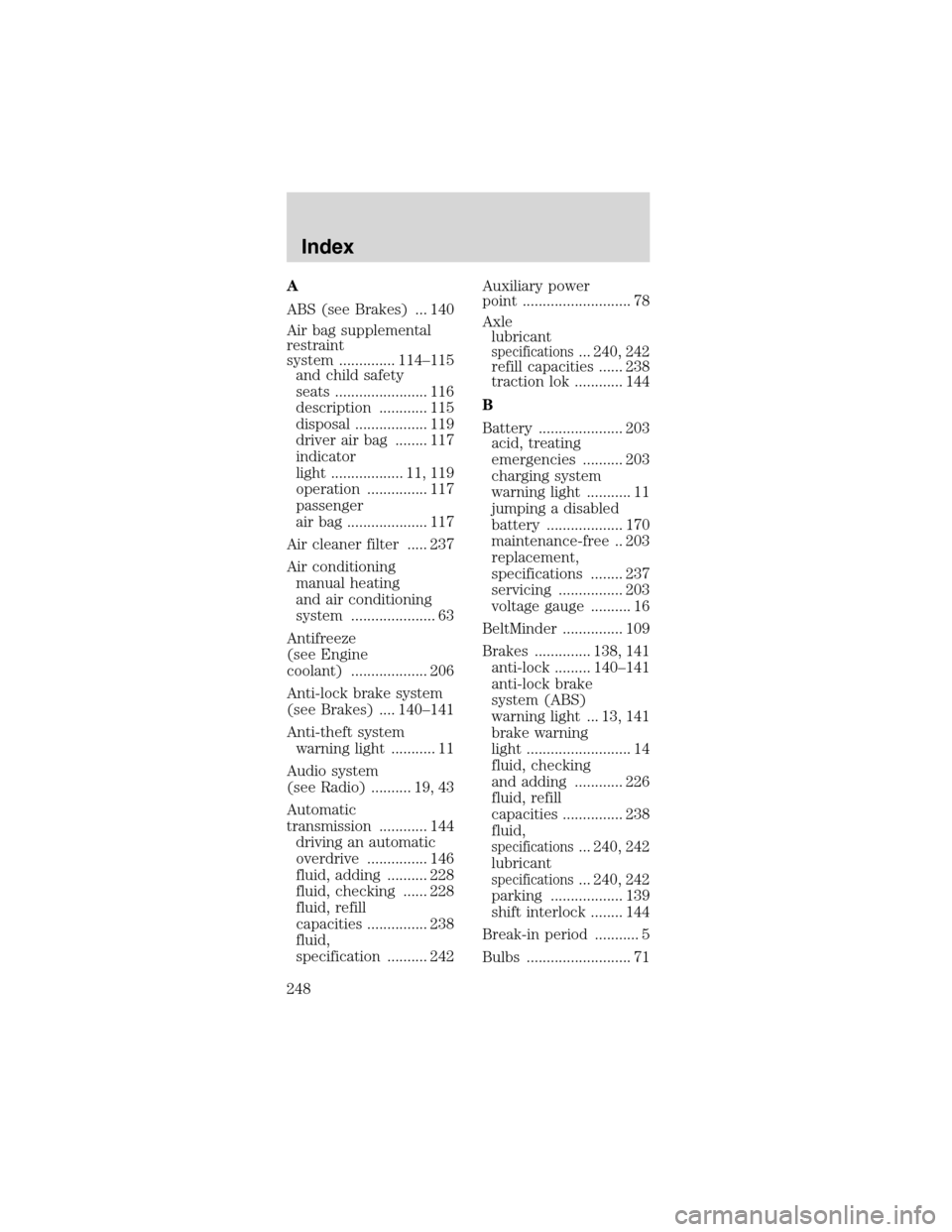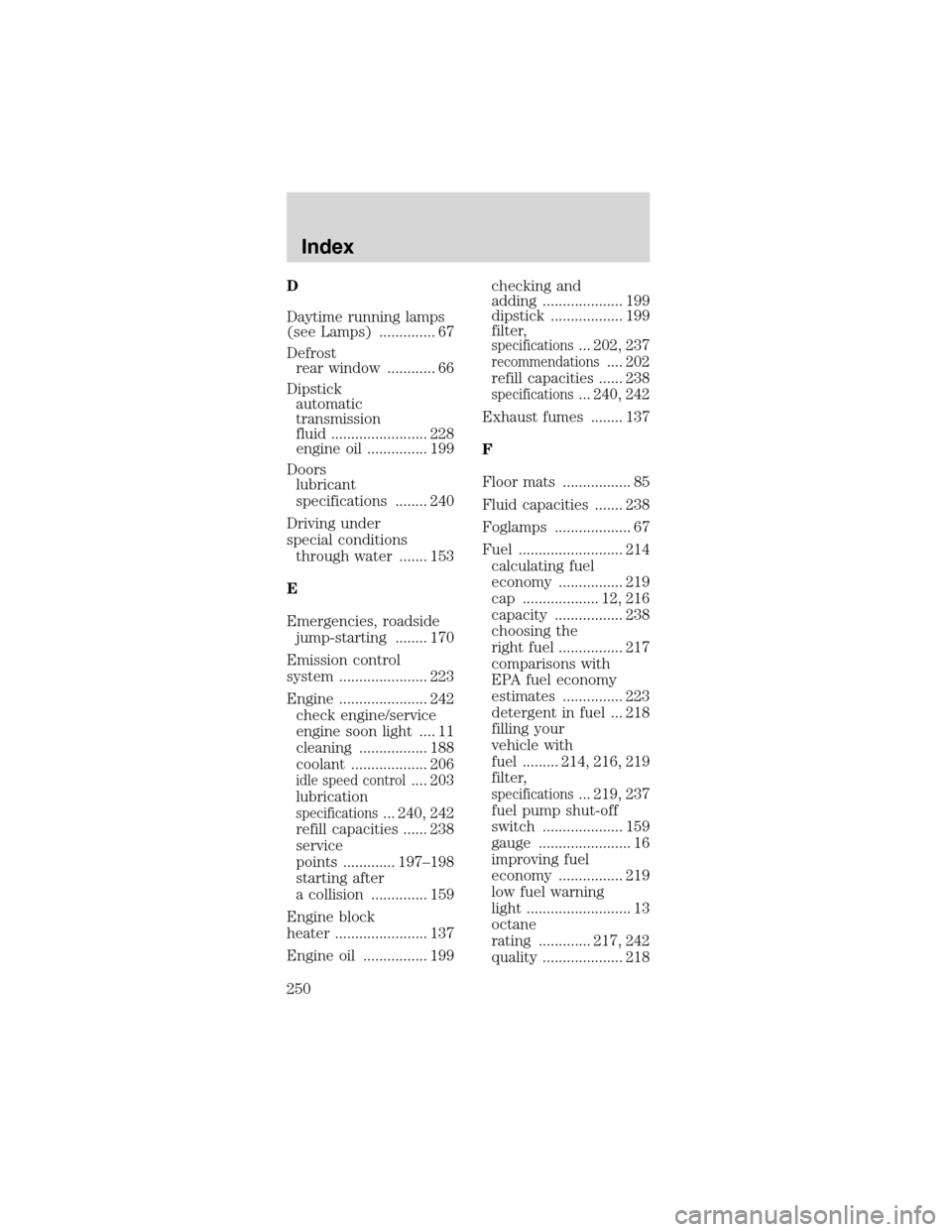2003 FORD MUSTANG check engine light
[x] Cancel search: check engine lightPage 199 of 256

WINDSHIELD WASHER FLUID
Check the washer fluid
whenever you stop for
fuel. The reservoir is
highlighted with a
symbol.
Add fluid to fill the
reservoir if the level is
low. In very cold
weather, do not fill the
reservoir completely.
Only use a washer fluid that meets Ford
specification ESR-M17P5–A . Refer toLubricant
specificationsin this chapter.
State or local regulations on volatile organic
compounds may restrict the use of methanol, a
common windshield washer antifreeze additive.
Washer fluids containing non-methanol antifreeze
agents should be used only if they provide cold
weather protection without damaging the vehicle’s
paint finish, wiper blades or washer system.
Note:Do not put washer fluid in the engine coolant
reservoir. Washer fluid placed in the cooling system
may harm engine and cooling system components.
ENGINE OIL
Checking the engine oil
Refer to the scheduled maintenance guide for the
appropriate intervals for checking the engine oil.
1. Make sure the vehicle is on level ground.
2. Turn the engine off and wait 5 to 10 minutes for
the oil to drain into the oil pan.
3. Set the parking brake and ensure the gearshift is
securely latched in P (Park) (automatic
transmissions) or 1 (First) (manual transmissions).
4. Open the hood. Protect yourself from engine heat.
Maintenance and Specifications
199
Page 216 of 256

Usethe following guidelines to avoid static build-up
when filling an ungrounded fuel container:
•Place approved fuel container on the ground.
•DO NOT fill a fuel container while it is in the
vehicle (including the cargo area).
•Keep the fuel pump nozzle in contact with the
fuel container while filling.
•DO NOT use a device that would hold the fuel
pump handle in the fill position.
Fuel Filler Cap
Your fuel tank filler cap has an indexed design with
a 1/8 turn on/off feature.
When fueling your vehicle:
1. Turn the engine off.
2. Carefully turn the filler cap counterclockwise 1/8
of a turn until it stops.
3. Pull to remove the cap from the fuel filler pipe.
4. To install the cap, align the tabs on the cap with
the notches on the filler pipe.
5. Turn the filler cap clockwise 1/8 of a turn until it
stops.
“Check Fuel Cap”illuminates when the ignition is
turned to the ON position to ensure your bulb is
working. When this light turns on, check the fuel
filler cap. Continuing to operate the vehicle with the
Check Fuel Cap light on, can activate the Service
Engine Soon warning. When the fuel filler cap is
properly re-installed, the light(s) will turn off after a
period of normal driving.It may take a long
period of time for the system to detect an
improperly installed fuel filler cap.
If you must replace the fuel filler cap, replace
it with a fuel filler cap that is designed for
your vehicle. The customer warranty may be
void for any damage to the fuel tank or fuel
system if the correct genuine Ford or
Motorcraft fuel filler cap is not used.
Maintenance and Specifications
216
Page 222 of 256

•Using the air conditioner or defroster may reduce
fuel economy.
•You may want to turn off the speed control in
hilly terrain if unnecessary shifting between third
and fourth gear occurs. Unnecessary shifting of
this type could result in reduced fuel economy.
•Warming up a vehicle on cold mornings is not
required and may reduce fuel economy.
•Resting your foot on the brake pedal while driving
may reduce fuel economy.
•Combine errands and minimize stop-and-go
driving.
Maintenance
•Keep tires properly inflated and use only
recommended size.
•Operating a vehicle with the wheels out of
alignment will reduce fuel economy.
•Use recommended engine oil. Refer toLubricant
specificationsin this chapter.
•Perform all regularly scheduled maintenance
items. Follow the recommended maintenance
schedule and owner maintenance checks found in
your vehicle scheduled maintenance guide.
Conditions
•Heavily loading a vehicle or towing a trailer may
reduce fuel economy at any speed.
•Carrying unnecessary weight may reduce fuel
economy (approximately 0.4 km/L [1 mpg] is lost
for every 180 kg [400 lb] of weight carried).
•Adding certain accessories to your vehicle (for
example bug deflectors, rollbars/light bars,
running boards, ski/luggage racks) may reduce
fuel economy.
•Using fuel blended with alcohol may lower fuel
economy.
•Fuel economy may decrease with lower
temperatures during the first 12–16 km (8–10
miles) of driving.
Maintenance and Specifications
222
Page 224 of 256

service of components affecting emission control,
such non-Ford parts should be equivalent to genuine
Ford Motor Company parts in performance and
durability.
Do not park, idle, or drive your vehicle in
dry grass or other dry ground cover. The
emission system heats up the engine compartment
and exhaust system, which can start a fire.
Illumination of the“Service Engine Soon”light,
charging system warning light or the temperature
warning light, fluid leaks, strange odors, smoke or
loss of engine power, could indicate that the
emission control system is not working properly.
Exhaust leaks may result in entry of harmful
and potentially lethal fumes into the
passenger compartment.
Do not make any unauthorized changes to your
vehicle or engine. By law, vehicle owners and anyone
who manufactures, repairs, services, sells, leases,
trades vehicles, or supervises a fleet of vehicles are
not permitted to intentionally remove an emission
control device or prevent it from working.
Information about your vehicle’s emission system is
on the Vehicle Emission Control Information Decal
located on or near the engine. This decal identifies
engine displacement and gives some tune up
specifications.
Please consult yourWarranty Guidefor complete
emission warranty information.
Readiness for Inspection/Maintenance (I/M)
testing
In some localities, it may be a legal requirement to
pass an I/M test of the on-board diagnostics system.
If your“Check Engine/Service Engine Soon”light is
on, refer to the description in theWarning lights
and chimessection of theInstrument cluster
chapter. Your vehicle may not pass the I/M test with
the“Check Engine/Service Engine Soon”light on.
Maintenance and Specifications
224
Page 248 of 256

A
ABS (see Brakes) ... 140
Air bag supplemental
restraint
system .............. 114–115
and child safety
seats ....................... 116
description ............ 115
disposal .................. 119
driver air bag ........ 117
indicator
light .................. 11, 119
operation ............... 117
passenger
air bag .................... 117
Air cleaner filter ..... 237
Air conditioning
manual heating
and air conditioning
system ..................... 63
Antifreeze
(see Engine
coolant) ................... 206
Anti-lock brake system
(see Brakes) .... 140–141
Anti-theft system
warning light ........... 11
Audio system
(see Radio) .......... 19, 43
Automatic
transmission ............ 144
driving an automatic
overdrive ............... 146
fluid, adding .......... 228
fluid, checking ...... 228
fluid, refill
capacities ............... 238
fluid,
specification .......... 242Auxiliary power
point ........................... 78
Axle
lubricant
specifications... 240, 242
refill capacities ...... 238
traction lok ............ 144
B
Battery ..................... 203
acid, treating
emergencies .......... 203
charging system
warning light ........... 11
jumping a disabled
battery ................... 170
maintenance-free .. 203
replacement,
specifications ........ 237
servicing ................ 203
voltage gauge .......... 16
BeltMinder ............... 109
Brakes .............. 138, 141
anti-lock ......... 140–141
anti-lock brake
system (ABS)
warning light ... 13, 141
brake warning
light .......................... 14
fluid, checking
and adding ............ 226
fluid, refill
capacities ............... 238
fluid,
specifications... 240, 242
lubricant
specifications... 240, 242
parking .................. 139
shift interlock ........ 144
Break-in period ........... 5
Bulbs .......................... 71
Index
248
Page 250 of 256

D
Daytime running lamps
(see Lamps) .............. 67
Defrost
rear window ............ 66
Dipstick
automatic
transmission
fluid ........................ 228
engine oil ............... 199
Doors
lubricant
specifications ........ 240
Driving under
special conditions
through water ....... 153
E
Emergencies, roadside
jump-starting ........ 170
Emission control
system ...................... 223
Engine ...................... 242
check engine/service
engine soon light .... 11
cleaning ................. 188
coolant ................... 206
idle speed control.... 203
lubrication
specifications... 240, 242
refill capacities ...... 238
service
points ............. 197–198
starting after
a collision .............. 159
Engine block
heater ....................... 137
Engine oil ................ 199checking and
adding .................... 199
dipstick .................. 199
filter,
specifications... 202, 237
recommendations.... 202
refill capacities ...... 238
specifications... 240, 242
Exhaust fumes ........ 137
F
Floor mats ................. 85
Fluid capacities ....... 238
Foglamps ................... 67
Fuel .......................... 214
calculating fuel
economy ................ 219
cap ................... 12, 216
capacity ................. 238
choosing the
right fuel ................ 217
comparisons with
EPA fuel economy
estimates ............... 223
detergent in fuel ... 218
filling your
vehicle with
fuel ......... 214, 216, 219
filter,
specifications... 219, 237
fuel pump shut-off
switch .................... 159
gauge ....................... 16
improving fuel
economy ................ 219
low fuel warning
light .......................... 13
octane
rating ............. 217, 242
quality .................... 218
Index
250
Page 253 of 256

Odometer ................... 17
Oil (see
Engine oil) ............... 199
Overdrive ........... 84, 146
P
Panic alarm feature,
remote entry
system ........................ 92
Parking brake .......... 139
Parts (see Motorcraft
parts) ....................... 237
Power distribution
box (see Fuses) ...... 163
Power door locks ...... 89
Power mirrors ........... 80
Power point ............... 78
Power steering ........ 142
fluid, checking
and adding ............ 225
fluid, refill
capacity ................. 238
fluid,
specifications... 240, 242
Power Windows ......... 78
R
Radio .................... 19, 43
Radio reception ... 61–62
Rear window
defroster .................... 66
Relays ...................... 160
Remote entry
system .................. 91–92
illuminated entry .... 94locking/unlocking
doors .................. 89, 92
opening the trunk ... 93
panic alarm ............. 92
replacement/additional
transmitters ............. 94
replacing the
batteries .................. 93
Roadside
assistance ................ 157
S
Safety belts (see
Safety restraints) ..... 14,
102, 104–107
Safety defects,
reporting .................. 186
Safety
restraints... 102, 104–107
belt minder ........... 109
cleaning the
safety belts ............ 113
extension
assembly ................ 113
for adults ....... 104–107
for children ... 119–120
warning light
and chime ............... 10,
14, 108–109
Safety seats
for children .............. 123
Seat belts (see Safety
restraints) ................ 102
Seats .......................... 99
child safety seats .. 123
SecuriLock passive
anti-theft
system .................. 95–97
Index
253